Tessa’s Recipe Rundown
Taste: Pure chocolate heaven.
Texture: This depends on the chocolate-to-cream ratio used; it can range from rich and fudge-like to creamy and sauce-like.
Ease: Super simple.
Why You’ll Love This Recipe: An easy way to elevate any dessert!
This post may contain affiliate links. Read our disclosure policy.
Chocolate Ganache is like liquid gold! It tastes rich and decadent, has a velvety smooth texture, and looks so pretty and elegant.
Its pure chocolate flavor feels so luxurious, but it’s surprisingly simple to make!
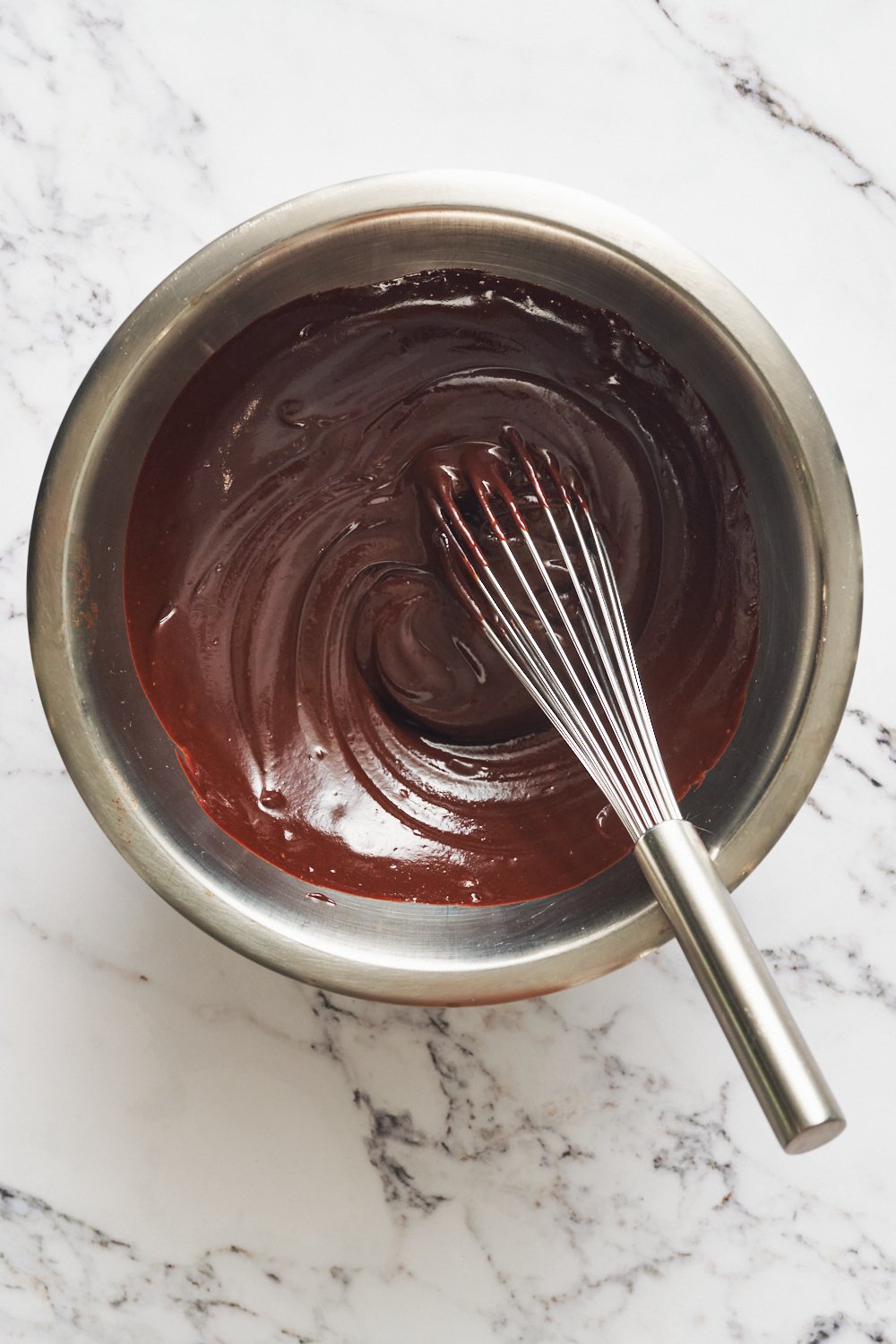
Ganache is incredibly versatile, making it a staple you’ll use again and again in your baking.

Free Ingredient Measuring Guide!
The key to consistent baking success is a click away. Sign up to get instant access to my printable Ingredient Measuring Guide now!
I love using ganache to elevate cakes like my Guinness Chocolate Cake with Irish Buttercream, in the form of heavenly Chocolate Truffles, or as a topping on my fantastic Death by Chocolate Cheesecake.
The secret to perfect ganache lies in a few simple details, so don’t miss my tips and tricks below and learn how to confidently get it right every time!

Sprinkle of Science
How to Make Chocolate Ganache
What is Ganache?
If you’ve ever sampled chocolate ganache, you may be surprised to learn that it’s a simple combination of two ingredients: chocolate and heavy whipping cream! The careful heating and combining of these two ingredients produce a rich, luscious chocolate that can be used as a cake filling, shiny frosting, decadent sauce, for making chocolate truffles, and more.
Ganache will never fully set like tempered chocolate will. It firms up as it cools and sets in the fridge, but it won’t form a crunchy crust. This means it’s the perfect topping for a special cake or beautiful cheesecake, as well as countless other uses. Enrobe ganache in tempered chocolate and you’ve got yourself a truffle!
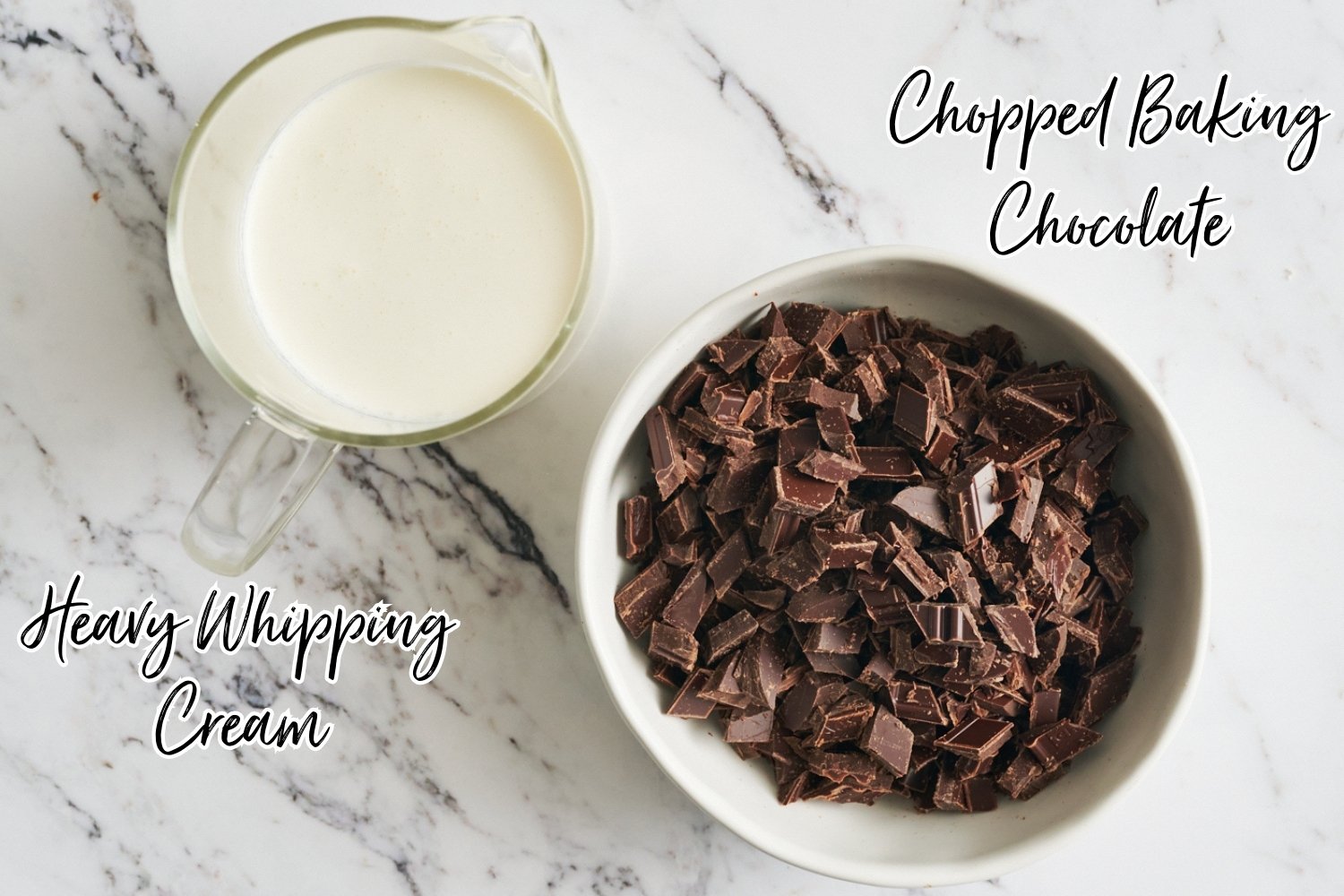
The Chocolate
Since ganache has only two ingredients, be sure to use the highest quality ingredients possible for the best flavor. I recommend using baking chocolate for ganache. Chop the chocolate with a serrated knife, being careful not to leave any large chunks.
Dark, Milk, or White Chocolate?
For the perfect balance of richness and sweetness, I recommend using semisweet chocolate in your ganache. Bittersweet chocolate is a great option if you prefer an intense chocolate flavor.
You can use milk chocolate or white chocolate, but keep in mind that unliked darker chocolate, they contain more milk, which makes it easier to scorch. Be sure not to overheat the cream when using these varieties (more on this below). The extra milk also creates a softer ganache, so I suggest reducing the amount of cream used by about a third to achieve the right consistency.
Learn more about Chocolate in Baking here.
Can I Use Chocolate Chips in Ganache?
While you technically can use chocolate chips, they won’t melt down as nicely because they contain ingredients to help them keep their chip shape. I recommend using baking bars and chopping them yourself for the smoothest texture.
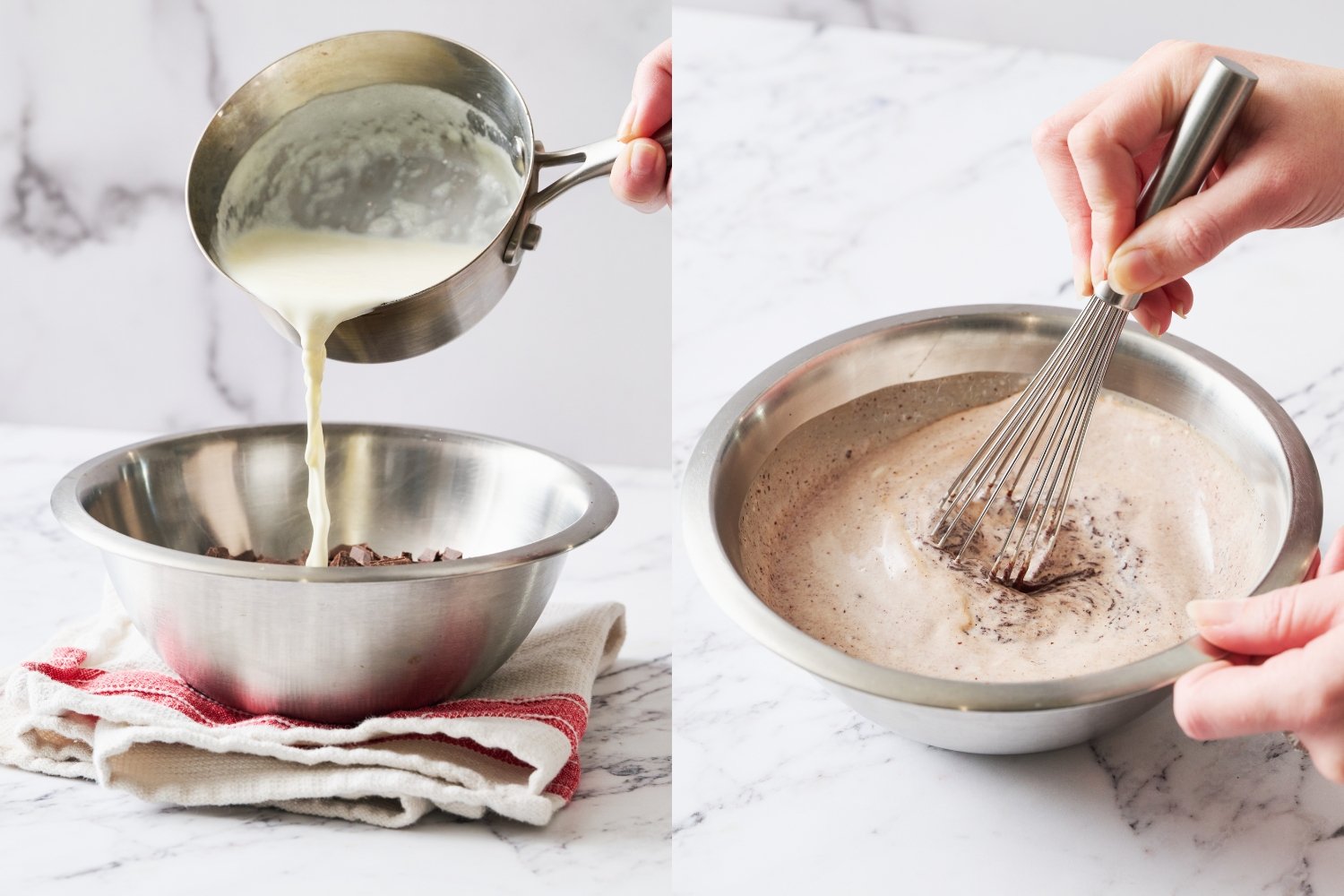
The Cream
Use heavy whipping cream (also called heavy cream) for ganache. The higher the fat content of the cream, the richer and more stable your ganache will be. Do not use whipped cream (like Cool Whip), milk, or half-and-half, as they won’t allow the ganache to thicken or set correctly.
I haven’t tested any nondairy alternatives, but feel free to experiment with full-fat coconut milk or coconut cream. Keep in mind that this may result in a slightly different texture and a prominent coconut flavor.
Don’t Overheat Your Cream!
- Temperature plays a key role in making ganache.
- If your cream gets too hot, the ganache can turn grainy or separate and won’t emulsify.
- This is especially true for milk or white chocolate, but it can happen with dark chocolate too.
- Heat your cream just to a simmer before pulling it off the stove.
- If using a microwave, watch it very carefully to avoid overheating.
- Stopping at a simmer, without letting it get any hotter, will prevent your ganache from splitting.
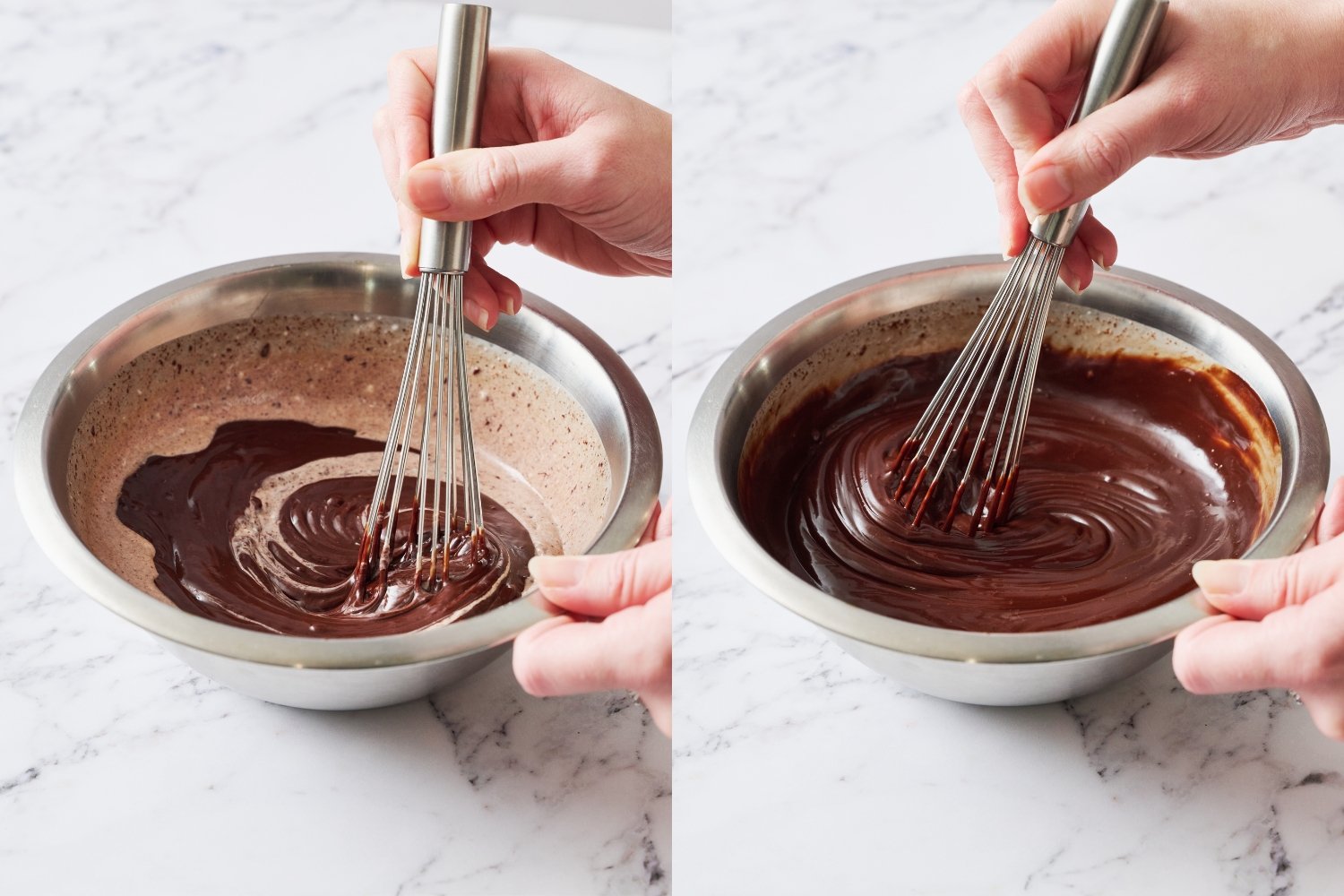
Basic Ganache Ratios
The ratio of chocolate to cream greatly impacts the final texture. The right ratio depends on your needs and preferences. Keep in mind that as ganache cools, it thickens and solidifies. Ganache with a higher chocolate ratio (such as for truffles) will set firmer, while ganache with more cream (like for glazes) will stay softer but will still firm up slightly over time.
Standard Ganache – 1:1 Ratio Ganache
Use equal parts chocolate and cream for a layer cake filling or a thick glaze, like with my Guinness Chocolate Cake with Irish Buttercream.
To glaze a cake, cheesecake, or other dessert with ganache:
- Let the ganache sit uncovered until it’s at room temperature, about 15 minutes, before pouring over the cold cake or cheesecake.
- Start pouring in the middle and gently work your way to the edges.
- If desired, let the ganache drip over the sides.
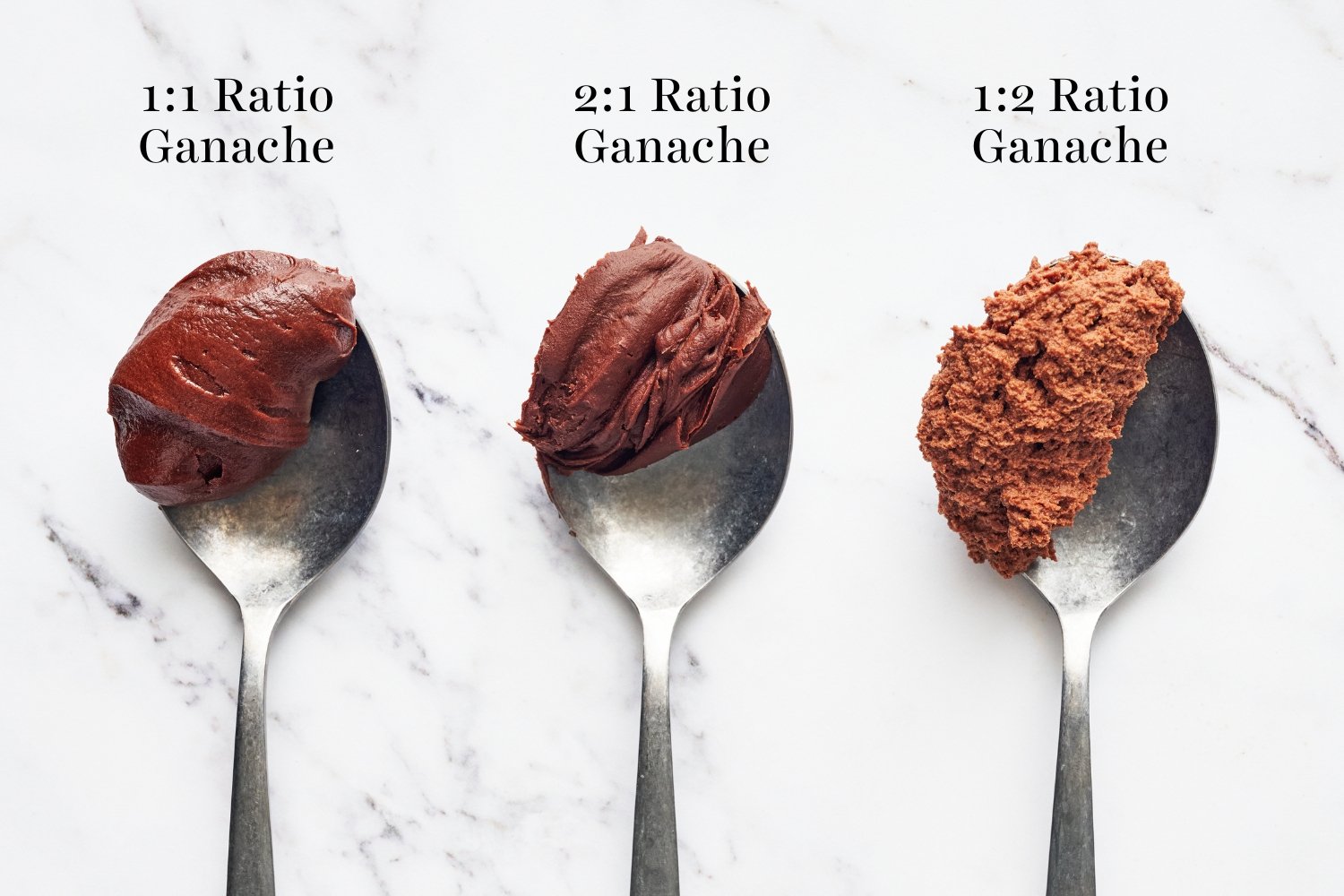
Thicker Ganache – 2:1 Ratio Ganache
For a very thick, almost fudge-like ganache, use twice as much chocolate as cream. This ratio is perfect for truffles or thick fillings for cookies, macarons, or tarts.
This ganache will solidify as it cools, especially in the fridge.
To achieve a solid yet chewy texture with a shiny finish, add 1 tablespoon of corn syrup to the cream.
For more tips on making truffles, check out my Ultimate Truffle Guide.
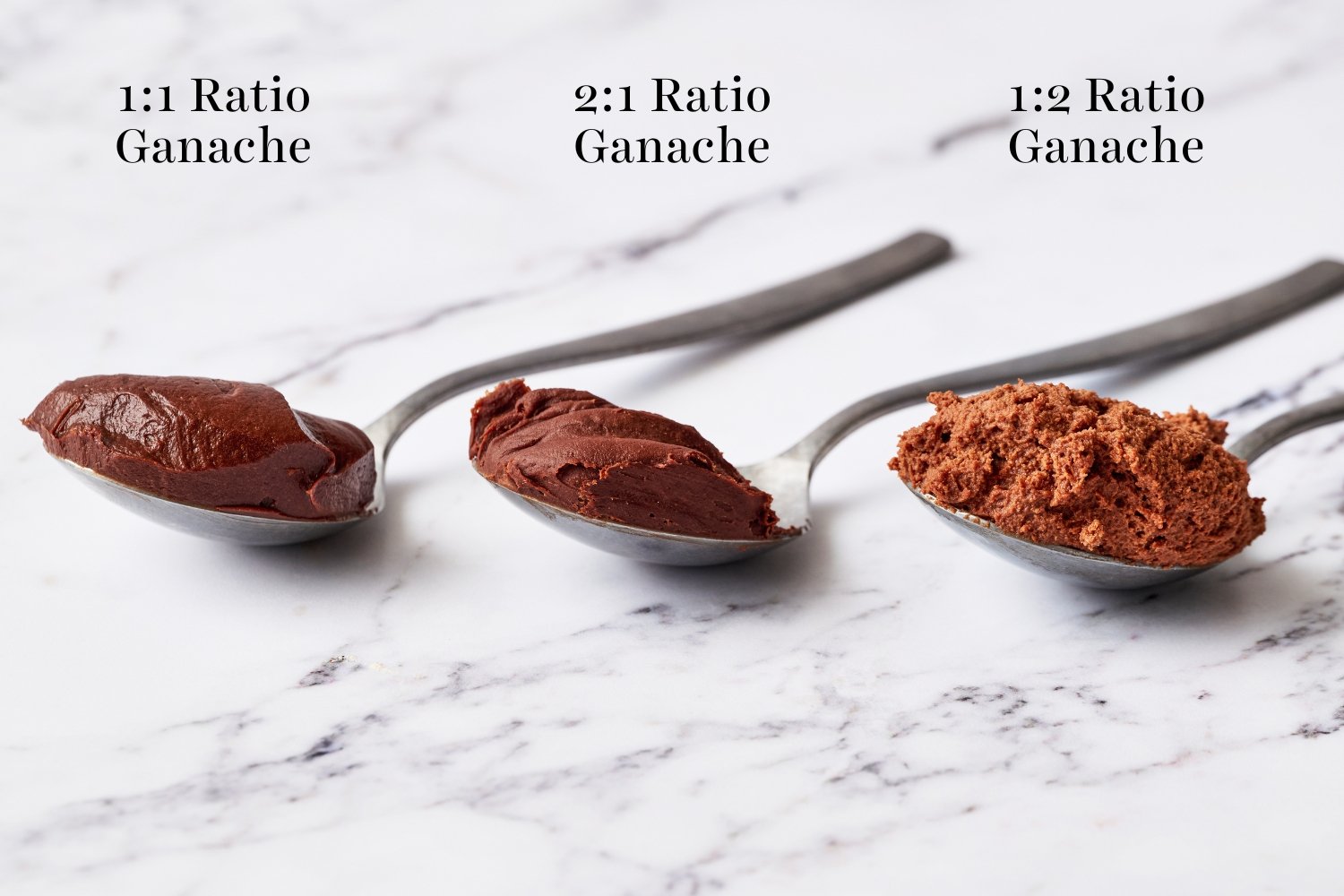
Thinner Ganache – 1:2 Ratio Ganache
For a thin, pourable ganache, use one part chocolate to two parts cream. This is perfect for dipping fruit or pouring over ice cream.
This ratio is also great for making whipped ganache (as shown in the photos), which has the taste and texture between chocolate whipped cream and mousse. It’s an incredible cake filling or cupcake frosting alternative. Allow ganache to cool completely before whipping.
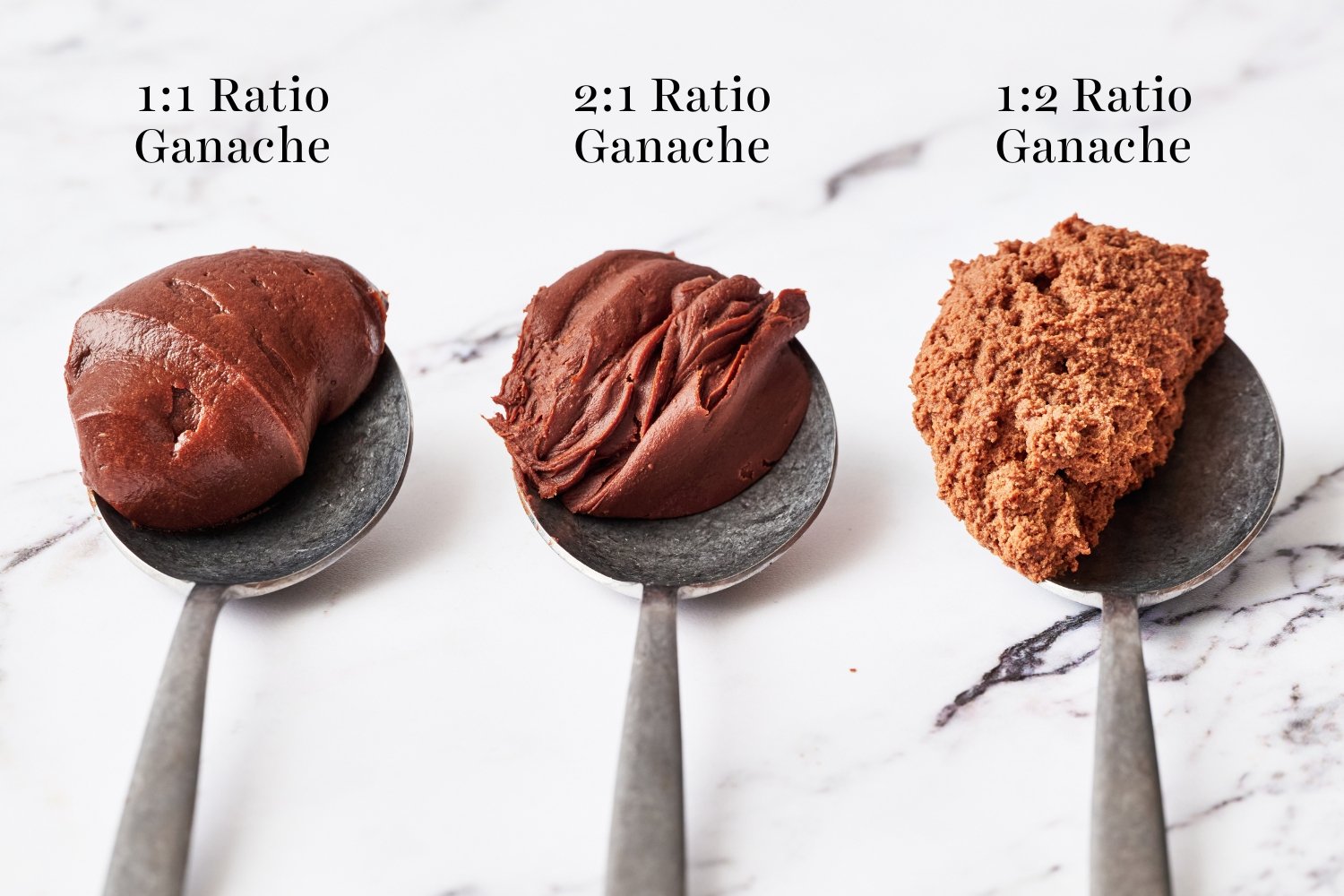
Ganache Flavor Options
Some of these flavor additions may change the consistency of the ganache. Add more cream to thin or more chocolate to thicken, as needed.
- Salt: Add 1/8 teaspoon salt to the hot mixture to enhance the sweetness of the ganache.
- Liqueurs and Brandies: Swap 1-2 ounces of the cream with a flavored liqueur (e.g., Grand Marnier, Bailey’s, Chambord, etc.) or brandy (e.g., Armagnac, Cognac) to the warm ganache.
- Other Flavorings: Stir in extracts, fruit purees, espresso powder, or spices to the warm ganache.
- Peanut Butter or Nutella: Mix in 2 tablespoons to 1/4 cup of smooth peanut butter or Nutella with the chocolate and hot cream.
- Cream Infusion: Heat the cream with flavorings like fresh mint, tea, herbs (like lavender), coffee beans, or citrus zest, and let it sit for 5 to 10 minutes. Strain before using. Rewarm the cream if needed before adding to the chocolate.
Can I Halve or Double the Ganache Recipe?
Yes – simply halve or double the amounts of chocolate and cream for whichever ratio you need, keeping the ratios the same (e.g., 1:1 cream to chocolate). No other modifications needed.
How to Store Ganache
Store completely cooled chocolate ganache in an airtight container in the refrigerator for up to 1 week. Store with plastic wrap pressed against the surface to prevent any film from forming.
Cakes, cupcakes, and other baked goods filled or garnished with ganache can sit at a cool room temperature for a few hours before being covered and refrigerated.
Can You Freeze Ganache?
Completely cooled ganache can be stored inside an airtight container and frozen for up to 3 months. Allow to thaw in the fridge then let come to room temperature before using. Place in a double boiler, stirring constantly, to gently reheat if needed.

More Chocolate Recipes You’ll Love:
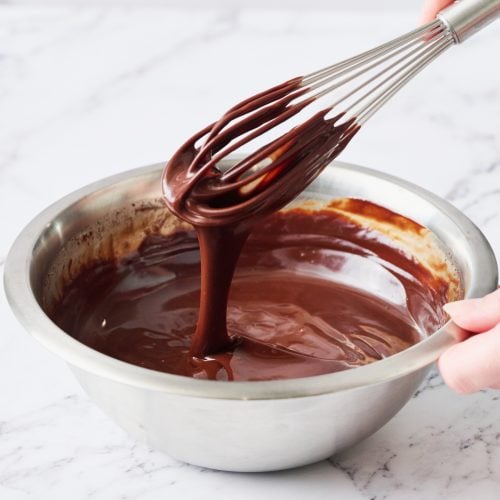
Chocolate Ganache
Email This Recipe
Enter your email, and we’ll send it to your inbox.
Ingredients
1:1 ratio ganache (for thick glazes, fillings, and frostings):
- 8 ounces (227 grams) chocolate
- 1 cup (240 grams) heavy cream
2:1 ratio ganache (for very thick, almost solid fudge-like ganache for truffles, tart fillings, etc.):
- 8 ounces (227 grams) chocolate
- 1/2 cup (120 grams) heavy cream
1:2 ratio ganache (for very thin, pourable ganache for dipping,drizzling, or whipping):
- 4 ounces (114 grams) chocolate
- 1 cup (240 grams) heavy cream
Instructions
- Coarsely chop the chocolate with a serrated knife then transfer to a heatproof bowl.
- Pour the cream into a small saucepan set over medium-high heat and bring just to a boil. Immediately remove from heat and pour over the chopped chocolate. Let stand for 5 to 10 minutes to allow the hot cream to melt the chocolate and to allow the overall temperature to reduce (emulsions form better at 90 to 110°F).
- Whisk the mixture in one direction until smooth and creamy. This may take a little while – just keep whisking until smooth, cohesive, and shiny.
- If using as a glaze, allow to cool for 15 minutes before pouring. If using for truffles, cover and chill for 1 hour, or until solid yet malleable, before scooping into balls. If using as a frosting, allow to chill for 4 hours, or until almost solidified, before using.
Whipped Ganache:
- To make whipped ganache, let a 1:2 ratio ganache chill in the fridge until thickened, about 1 hour. Whip with an electric mixer fitted with the whisk attachment, slowly increasing the speed to medium-high. Whip until light in color and fluffy in texture. Be careful not to overwhip as this can create a grainy texture. If this happens, reheat the ganache in a double boiler, then strain and start again.
Recipe Notes
This post was originally published in 2015 and has been updated with additional recipe tips, Baking Science information, and new photos. Photos by Joanie Simon.
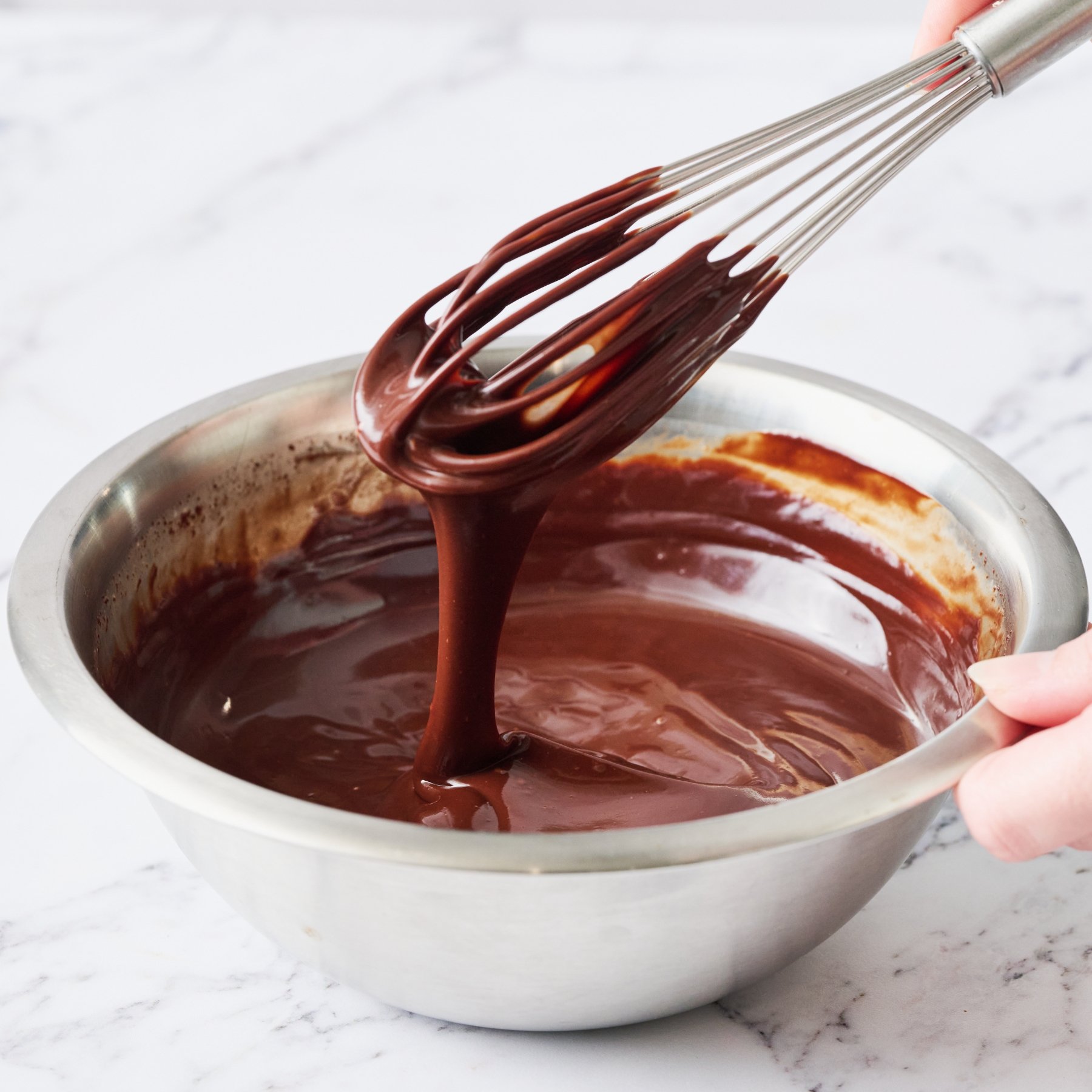

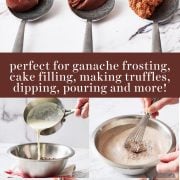
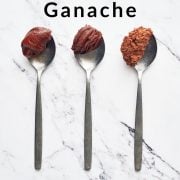

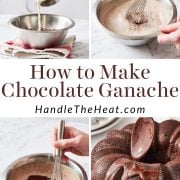
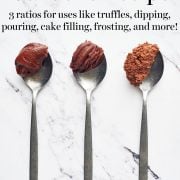
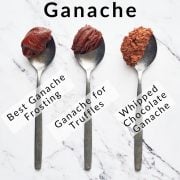
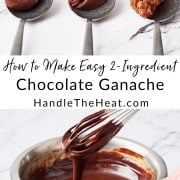
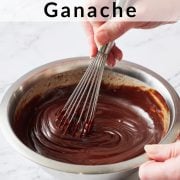

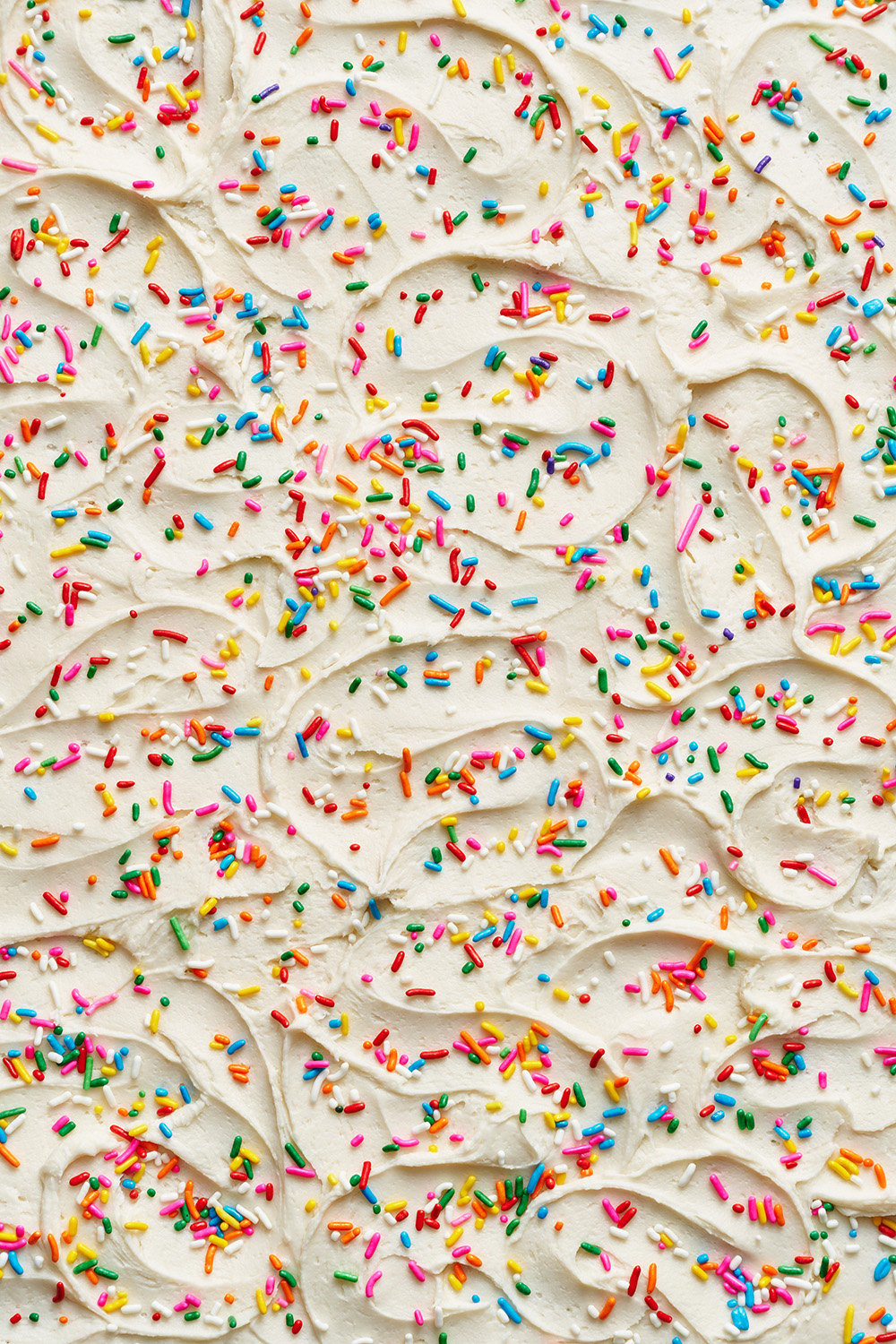

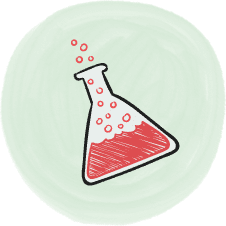


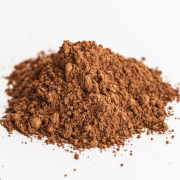
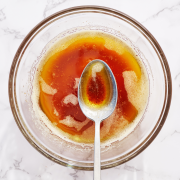
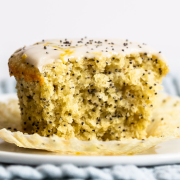
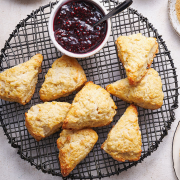
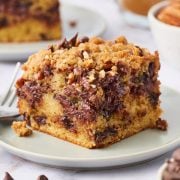




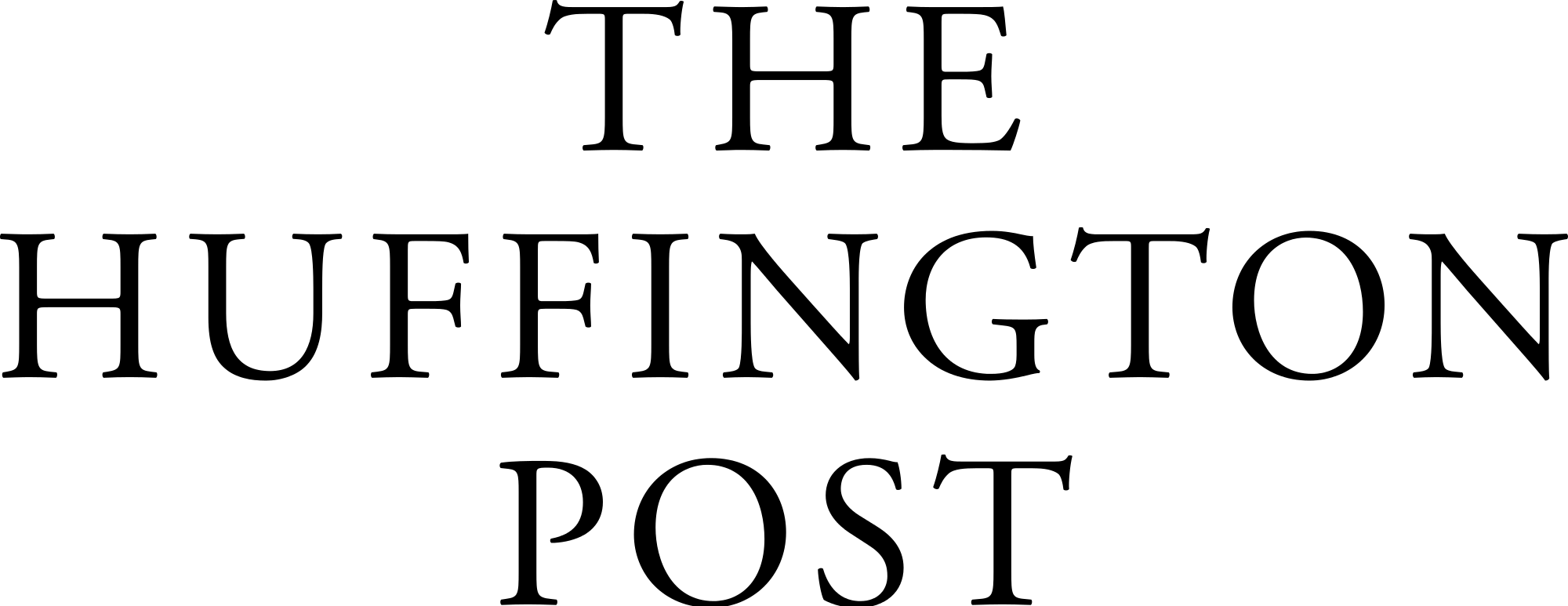




Hi!
I was thinking of making a ganache to cover small ice cream cakes filled with a fruit curd.
Which ganache version should I make.
They’ll be re-frozen after adding the ganache and served after about 20 min out of the freezer. I want the ganache to be a thin shell.
Hi Mike! As mentioned in the post, the 1:2 Ratio will give you a nice pourable ganache. Make sure it’s not too hot when you pour it, or it’ll melt your ice cream and become transparent. The ganache will likely lose its shine when frozen, and it won’t be a ‘shell’, per se, as ganache doesn’t fully harden thanks to the cream. I recommend looking into tempering chocolate as this will give you a nice, shiny finish to your desserts, with a thin, crisp crust. Enjoy your desserts!
Hello, I am still unsure re wgt vs volume. I read your response to someone who asked this but I’m not clear. In the example for the thicker frosting, 1/2 or 4oz cream is clearly a volume measurement. Is the 8oz chocolate by wgt or is it 1 cup volume, 8oz.
Hi Den! This recipe is volume for the heavy cream and the chocolate is listed as weight. So, 1:1 ratio for thick glazes, fillings, and frostings is:
8 ounces chocolate (weight) + 1 cup (8 ounces) heavy cream (volume).
I hope that helps! 🙂
Hi, I have a question about what I have seen referred to as “broken” ganache. I made a recipe which called for a chocolate ganache and followed those instructions and it came out fine. the second time I made it, I believe I halved the recipe and it never emulsified– just separated with the layer of grease and even though I tried to add some chocolate I could never get it right. I expected that it was something about my halving the recipe that did it, though I really did think that I had the same ratio. Any other ideas about what might have been the problem? From reading this tutorial, it seems that there is more than one ratio that can work.
Thanks!
Hi Susan! Temperature plays a key role in making ganache. If your heavy cream gets too hot, it can cause your chocolate to separate, resulting in grainy ganache, or separated butter that won’t emulsify. This is especially important when using milk or white chocolate, as they will separate more easily – but it can still happen with darker chocolates, too. It’s so easy to overheat the cream if you step away from the stove for even a moment, or if you’re using a microwave to heat the cream – and especially if you’re trying the same technique and timing with half the amount of cream. Next time you give this a try (with whichever ratio you prefer, as Tessa outlines on this page), bring your cream just to a boil, before pulling it off the stove and pouring over your chopped chocolate. Allowing the cream to just get to the point of boiling, without allowing it to get any hotter than this, should prevent your ganache from splitting/breaking. Let us know how it goes! 🙂
The Ganache recipe calls for chocolate. What kind of chocolate?
Thanks Patsy
Hi Patsy! Any good quality dark chocolate will be perfect. Semi-sweet, dark, bittersweet – any of these will be great. Hope that helps 🙂
Hi – Are the ratios the same for white chocolate?
Hi Christina! As Tessa mentions in the article, “You can use milk or white chocolate, but note that since they contain much more milk than semisweet or bittersweet chocolate they can be more susceptible to heat damage. This means you must be very careful not to overheat. Additionally, the extra milk in these chocolates also makes for a softer ganache, so reduce the amount of cream used.” If you’re looking for a whipped white chocolate ganache, Tessa has one with this cake recipe here! 🙂
Very good read.
I’m having an issue. I made a brownie base and wanted a soft chocolate ganache that’s really smooth, soft and holds its shape after refrigerating so I can cut it into bars for dessert – the problem I have is that it sets hard even when I half the chocolate. Is it ganache I’m thinking of or some other chocolate name for what I’m trying to achieve. I want to work from the fridge so how do I get a soft truffle rich glossy chocolate topping that isn’t hard from the fridge?
Thank you
Scott
Hi Scott! Yes, what you’re describing does sound like a ganache! Your chocolate-to-cream ratio might still be a little too high. Try the ganache our Cosmic Brownies feature on top! Hopefully that will work better for you 🙂
Thank you!!!
Made the 1:1 ratio ganache! It turned out perfect!
Sorry to hear you experienced issues, Riss, I’d love to help figure out what went wrong! How long did you let the 1:2 ratio ganache chill in the fridge for after melting the ingredients together? It sounds to me like your cream to chocolate ratio was off. If that’s the case, adding more chocolate to it should help thicken it up and help set.
You mentioned that almond milk/non-dairy milks won’t work as well, but I can attest that non-dairy creamers work wonderfully and taste so decadent! No need to kill cows or rip baby cows away from their mothers for ganache or scrumptious truffles!
Such a good post! Exactly what I needed (literally googled ‘different proportions of chocolate and cream in ganache’)
So glad you found this helpful!
Thanks for your recipes..it’s very helpful and easy to understand